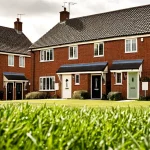Immediate benefits of integrating sustainable practices in home interiors
Embracing sustainable home interiors brings immediate, tangible benefits that improve daily living. One key advantage is the improvement of indoor air quality through the use of non-toxic materials, which reduces allergens and harmful chemicals, fostering healthier living environments. This directly impacts respiratory health and overall wellbeing.
Another crucial benefit is the reduction of environmental footprint. Eco-friendly design choices, such as energy-efficient lighting and sustainably sourced materials, lower energy consumption and waste. Over time, this translates into significant long-term savings on utility bills, making sustainable interiors financially smart as well as ecological.
Beyond health and cost, sustainable interiors promote enhanced comfort and aesthetics. Natural light optimization, better ventilation, and the use of organic textures create inviting spaces that support mental wellbeing. These spaces feel more harmonious and calming, illustrating how the benefits of eco-friendly design extend beyond functionality to enrich everyday life.
Incorporating sustainable home interiors effectively addresses multiple priorities—health, economy, and comfort—making it an increasingly compelling choice for modern living.
Immediate benefits of integrating sustainable practices in home interiors
Sustainable home interiors notably enhance indoor air quality, a primary concern for many homeowners. Using materials free from harmful chemicals and volatile organic compounds prevents pollutants from accumulating indoors. This fosters healthier living environments by minimizing respiratory irritations and allergic reactions. The benefits of eco-friendly design extend beyond air quality; such interiors also minimize exposure to toxins long associated with traditional building products.
In terms of cost, sustainable choices lead to reduced energy consumption, directly cutting utility bills. Energy-efficient lighting and appliances maximize resource use, contributing to an overall reduction of environmental footprint. Over time, these savings justify initial investments and support more responsible living.
Comfort also improves through sustainable design. Interiors optimised for natural light and ventilation create a brighter, more inviting atmosphere. Organic textures and eco-friendly finishes add to the aesthetic appeal, reinforcing the benefits of eco-friendly design by promoting wellbeing and mental clarity. Integrating these sustainable practices thus delivers a blend of health, financial, and sensory benefits—making homes not just greener, but genuinely better places to live.
Immediate benefits of integrating sustainable practices in home interiors
Integrating sustainable home interiors immediately enhances healthier living environments primarily through improved indoor air quality. By selecting low-VOC paints and non-toxic materials, homes experience fewer airborne irritants and allergens. This reduction in indoor pollutants directly supports better respiratory health and overall wellbeing, addressing common concerns about indoor contamination.
The benefits of eco-friendly design also manifest in energy savings and decreased ecological impact. Installing energy-efficient lighting and appliances lowers electricity consumption, contributing to a measurable reduction of environmental footprint. Additionally, sustainable materials often have longer lifespans, reducing waste and ongoing replacement costs, which adds up to long-term savings beyond utility bills.
Comfort and aesthetics gain as well, as sustainable designs prioritize natural light and ventilation to create more pleasant, calming spaces. Incorporation of organic textures and finishes not only appeals visually but also reinforces sensory wellbeing. Together, these elements make sustainable interiors healthier, more cost-effective, and more enjoyable for occupants—delivering immediate, multi-faceted benefits.
Immediate benefits of integrating sustainable practices in home interiors
Sustainable home interiors enhance indoor air quality by using low-emission materials like non-toxic paints and formaldehyde-free furniture. This prevents common allergens and chemicals from accumulating, directly contributing to healthier living environments.
In addition to health, these interiors substantially lower the environmental footprint. By choosing sustainable materials with reduced production impacts and integrating energy-saving appliances, homes reduce carbon emissions and waste generation. This combination offers notable benefits of eco-friendly design, including consistent long-term savings through decreased energy bills and material replacements.
Comfort and wellbeing are further strengthened in sustainable interiors. Design elements focused on maximizing natural light and promoting air circulation create spaces that feel nourishing and calming. Organic textures and finishes not only enrich aesthetics but support sensory wellness, enhancing the emotional connection homeowners feel with their surroundings.
In summary, the immediate benefits of sustainable home interiors extend clearly across three pillars: improved health, responsible environmental impact, and elevated comfort. This holistic value makes it easier to embrace sustainable choices confidently.
Immediate benefits of integrating sustainable practices in home interiors
Choosing sustainable home interiors significantly improves indoor air quality, a crucial factor in fostering healthier living environments. Many synthetic materials release volatile organic compounds (VOCs) that impair respiratory health. Selecting low-emission or natural products limits these toxins, reducing allergic reactions and enhancing comfort. This benefit is particularly important for households with children, elderly members, or those sensitive to chemicals.
Beyond health, sustainable interiors contribute to a noticeable reduction of environmental footprint. Using energy-efficient lighting and appliances cuts down electricity consumption, while eco-friendly building materials usually feature lower embodied carbon. Over time, these choices lead to long-term savings by lowering utility bills and minimizing material replacements.
Furthermore, sustainable design enhances overall wellbeing through improved aesthetics and comfort. Homes optimized for natural light and ventilation create inviting atmospheres that soothe mental stress. Organic textures and finishes introduce warmth and tactile appeal, boosting sensory satisfaction. These factors illustrate how the benefits of eco-friendly design reach far beyond environmental responsibility, creating spaces that are not only better for the planet but healthier and more enjoyable for occupants.







